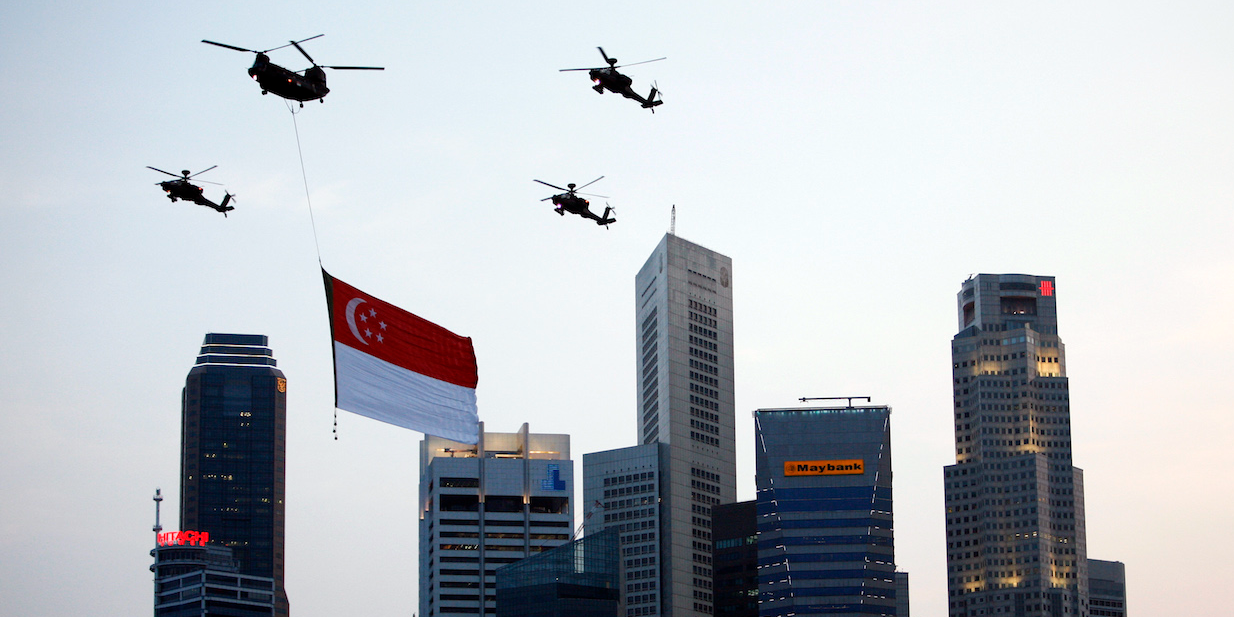- Singapore is an island city-state with the best air force and navy in Southeast Asia, and one of the most powerful militaries in the world.
- The country’s vast wealth enables it to buy and produce the best equipment available
- Singapore has been able to integrate complex weapons systems and training tactics flawlessly, making its military a strong cohesive unit.
When thinking of countries that have the strongest militaries in the world, giants like the US, Russia, China, and the UK come to mind. In Asia – and Southeast Asia in particular – China, Indonesia, Vietnam, and Thailand are usually mentioned.
But the country that boasts the best air force and navy in the region, and a military that is considered one of the most powerful in the world, is a tiny island city-state with a population of only 5 million – Singapore.
Strong since independence
The concept of a strong military has been ingrained in Singapore since it gained independence from Malaysia in 1965.
"Historically, Singapore had rather tumultuous relations with its immediate neighbors, namely Indonesia and Malaysia," Collin Koh Sw ee Lean, a research fellow at the S. Rajaratnam School of International Studies Maritime Security Programme, told Business Insider. "This was quite the case back in the early decades of Singapore's independence."
As a result, Singapore needed to invest in its security forces. "There was a sense in Singapore that they were extremely vulnerable to coercion being so small," Scott Harold, the associate director of the RAND Corporation's Center for Asia Pacific Policy, told Business Insider.

But with a small population and hardly any territory to train on let alone fight, it became clear that the only way they could secure their country was by out-competing their potential rivals through high-end technology.
'A poisonous shrimp'
Singapore's air force boasts 60 US made F-16C/D and 40 F-15SG that were designed specifically for the the Singapore Air Force. They also operate 20 AH-64D Apache Longbow helicopters, one of the best gunships currently in service.
Singapore's navy has six Formidable-class stealth frigates, licensed Singaporean-made versions of France's La Fayette-class frigate, a number of high-end submarines both in service and in development, and five Endurance-class landing platform docks than can carry 18 tanks and hundreds of troops.
The army is small compared to some of its regional rivals, with only 72,000 active personnel. But it has some of the best equipment in service, and much of it was either entirely produced or improved on by domestic companies.
This includes the Leopard 2SG, Bionix Infantry Fighting Vehicle, and the Terrex Infantry Carrier Vehicle. The country also has compulsory military service, and can quickly mobilize its army for war at a moments notice.

All of this high-end equipment is, unsurprisingly expensive. But despite its small size, Singapore has managed to become a global economic and military powerhouse.
Last year, Global Finance magazine ranked Singapore as the 4th richest country in the world in terms of GDP, and it has been able to stay high on that list for decades.
The city-state has historically had a high defense budget, usually hovering around three to four percent of its GDP, though it has gone as high as 5% in the past. This year's military budget, $14.76 billion, makes up 18% of Singapore's annual budget.
But what really sets Singapore apart from its neighbors in the realm of technology and equipment, is the fact that it is all integrated into a single cohesive fighting force.
"Not only do they have high-end equipment, they know how to operate it in a very high level of capability. It's integrated as opposed to all the other country in Southeast Asia," Brian Harding, the deputy director the Center for Strategic & International Studies' Southeast Asia Program, told Business Insider.
"They focus on making sure their systems work together, they have interoperability between the services. They are highly professional military," Harding said. "A poisonous shrimp is the analogy that is made."
Geographic difficulties

But Singapore's military does have a a big problem - geography. There simply isn't enough room on the island to train its fighting forces.
"If you're in a fighter jet that is taking off at three or four hundred miles an hour, you very quickly leave Singaporean airspace," Harold said.
As a result, Singapore has sent some of its soldiers and much of its equipment overseas. Its military has personnel and air squadrons in the US, Australia, Brunei, New Zealand, and Taiwan to name a few.
While the main purpose for these deployments in for training, it does offer another advantage - the ability to stage an effective counter-strike.
"The idea of distributing manpower and assets abroad ... also provide a recessed type of backup reinforcements, a form of insurance, in case forces deployed within Singapore got wiped out in an enemy onslaught," Koh said.
"These assets could therefore be mobilized as a follow-on force, possibly reinforced by friendly partners," he added.
Singapore's relations with its immediate neighbors have actually improved remarkably. In Koh's words, they "have never been as good as now."
Singapore has also contributed to international operations like Afghanistan and disaster relief missions to affected nations.

But Singapore is still cautious. Chinese actions in the South China Sea have not been encouraging, and its continued support of a US military presence in the region is not popular with some.
"Singaporeans are the ultimate realists and understand that things can change quickly," Harding said. "They know that they need to be prepared for the future and not just hope for the best."
